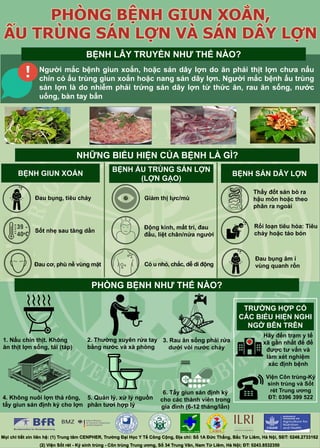Prevention of helminthiasis, swine fluke larvae and pork tapeworm (in Vietnamese)
•
0 likes•134 views
Poster prepared for the 'Safer indigenous pork and healthier ethnic minorities in Vietnam through better management of parasitic pig-borne diseases' project.
Report
Share
Report
Share
Download to read offline

Recommended
More Related Content
What's hot (8)
More from ILRI
More from ILRI (20)
How the small-scale low biosecurity sector could be transformed into a more b...

How the small-scale low biosecurity sector could be transformed into a more b...
Small ruminant keepers’ knowledge, attitudes and practices towards peste des ...

Small ruminant keepers’ knowledge, attitudes and practices towards peste des ...
Small ruminant keepers’ knowledge, attitudes and practices towards peste des ...

Small ruminant keepers’ knowledge, attitudes and practices towards peste des ...
A training, certification and marketing scheme for informal dairy vendors in ...

A training, certification and marketing scheme for informal dairy vendors in ...
Milk safety and child nutrition impacts of the MoreMilk training, certificati...

Milk safety and child nutrition impacts of the MoreMilk training, certificati...
Preventing the next pandemic: a 12-slide primer on emerging zoonotic diseases

Preventing the next pandemic: a 12-slide primer on emerging zoonotic diseases
Preventing preventable diseases: a 12-slide primer on foodborne disease

Preventing preventable diseases: a 12-slide primer on foodborne disease
Preventing a post-antibiotic era: a 12-slide primer on antimicrobial resistance

Preventing a post-antibiotic era: a 12-slide primer on antimicrobial resistance
Food safety research in low- and middle-income countries

Food safety research in low- and middle-income countries
The application of One Health: Observations from eastern and southern Africa

The application of One Health: Observations from eastern and southern Africa
One Health in action: Perspectives from 10 years in the field

One Health in action: Perspectives from 10 years in the field
Reservoirs of pathogenic Leptospira species in Uganda

Reservoirs of pathogenic Leptospira species in Uganda
Assessing meat microbiological safety and associated handling practices in bu...

Assessing meat microbiological safety and associated handling practices in bu...
Ecological factors associated with abundance and distribution of mosquito vec...

Ecological factors associated with abundance and distribution of mosquito vec...
Development of a fluorescent RBL reporter system for diagnosis of porcine cys...

Development of a fluorescent RBL reporter system for diagnosis of porcine cys...
Practices and drivers of antibiotic use in Kenyan smallholder dairy farms

Practices and drivers of antibiotic use in Kenyan smallholder dairy farms
Prevention of helminthiasis, swine fluke larvae and pork tapeworm (in Vietnamese)
- 1. tay, NHỮNG BIỂU HIỆN CỦA BỆNH LÀ GÌ? BỆNH GIUN XOẮN BỆNH ẤU TRÙNG SÁN LỢN (LỢN GẠO) PHÒNG BỆNH NHƯ THẾ NÀO? BỆNH SÁN DÂY LỢN 1. Nấu chín thịt. Không ăn thịt lợn sống, tái (táp) 2. Thường xuyên rửa tay bằng nước và xà phòng 3. Rau ăn sống phải rửa dưới vòi nước chảy 5. Quản lý, xử lý nguồn phân tươi hợp lý 4. Không nuôi lợn thả rông, tẩy giun sán định kỳ cho lợn 6. Tẩy giun sán định kỳ cho các thành viên trong gia đình (6-12 tháng/lần) TRƯỜNG HỢP CÓ CÁC BIỂU HIỆN NGHI NGỜ BÊN TRÊN Viện Côn trùng-Ký sinh trùng và Sốt rét Trung ương ĐT: 0396 399 522 Hãy đến trạm y tế xã gần nhất để để được tư vấn và làm xét nghiệm xác định bệnh Người mắc bệnh giun xoắn, hoặc sán dây lợn do ăn phải thịt lợn chưa nấu chín có ấu trùng giun xoắn hoặc nang sán dây lợn. Người mắc bệnh ấu trùng sán lợn là do nhiễm phải trứng sán dây lợn từ thức ăn, rau ăn sống, nước uống, bàn tay bẩn BỆNH LÂY TRUYỀN NHƯ THẾ NÀO? Đau cơ, phù nề vùng mặt Sốt nhẹ sau tăng dần Đau bụng, tiêu chảy Có u nhỏ, chắc, dễ di động Giảm thị lực/mù Động kinh, mất trí, đau đầu, liệt chân/nửa người Đau bụng âm ỉ vùng quanh rốn Rối loạn tiêu hóa: Tiêu chảy hoặc táo bón Thấy đốt sán bò ra hậu môn hoặc theo phân ra ngoài Mọi chi tiết xin liên hệ: (1) Trung tâm CENPHER, Trường Đại Học Y Tế Công Cộng, Địa chỉ: Số 1A Đức Thắng, Bắc Từ Liêm, Hà Nội, SĐT: 0246.2733162 (2) Viện Sốt rét - Ký sinh trùng - Côn trùng Trung ương, Số 34 Trung Văn, Nam Từ Liêm, Hà Nội; ĐT: 0243.8532350
